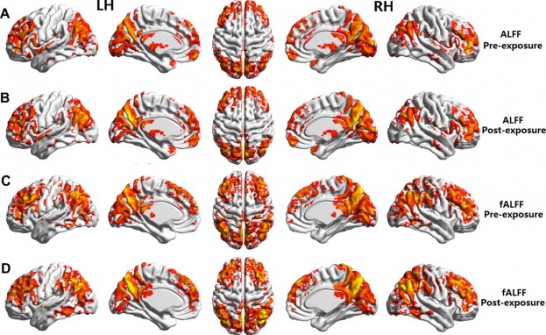LTE Cell Phone Radiation Affects Brain Activity in Cell Phone Users
PRLog (Press Release) – Sep. 23, 2013 – BERKELEY, Calif. — The first study on the short-term effects of Long Term Evolution (LTE), the fourth generation cell phone technology, has been published online in the peer-reviewed journal, Clinical Neurophysiology. (1)
In a controlled experiment, researchers exposed the right ear of 18 participants to LTE cellphone radiation for 30 minutes. The source of the radiation was 1 centimeter from the ear, and the absorbed amount of radiation in the brain was well within international (ICNIRP) cell phone legal limits. The researchers employed a double-blind, crossover, randomized and counter-balanced design to eliminate any possible study biases.
The resting state brain activity of each participant was measured by magnetic resonance imaging (fMRI) at two times — after exposure to LTE microwave radiation, and after a sham exposure.
The results demonstrated that LTE exposure affected brain neural activity not only in the closer brain region but also in the remote region, including the left hemisphere of the brain. The study helps explain the underlying neural mechanism for the remote effects of microwave radiation in the brain.
In 2011, Dr. Nora Volkow, Director of the National Institute on Drug Abuse, published a similar study in the Journal of the American Medical Association that “received worldwide news coverage. Dr. Volkow reported that a 50 minute exposure to CDMA, a second generation cell phone technology, increased brain activity in the region of the brain closest to the cell phone. (2)
The current study establishes that short-term exposure to LTE microwave radiation affects the users’ brain activity. Although LTE is too new for the long-term health consequences to have been studied, we have considerable evidence that long-term cell phone use is associated with various health risks including increased risk of head and neck cancers, sperm damage, and reproductive health consequences for offspring (i.e., ADHD).
Cell phone users, especially pregnant women and children, should limit their cell phone use. Moreover, cell phone users should not keep their phones near their head, breasts or reproductive organs when using the phone or whenever the phone is turned on unless it is in airplane mode.
For more information about the health effects of cell phone radiation see my Electromagnetic Radiation Safety Web site at http://www.saferemr.com/
Joel M. Moskowitz, Ph.D.
School of Public Health Health
University of California, Berkeley
Electromagnetic Radiation Safety
Website: http://www.saferemr.com
Facebook: http://www.facebook.com/
Twitter: @berkeleyprc
References
(1) Bin Lv, Zhiye Chen, Tongning Wu, Qing Shao, Duo Yan, Lin Ma, Ke Lu, Yi Xie. The alteration of spontaneous low frequency oscillations caused by acute electromagnetic fields exposure. Clinical Neurophysiology. Published online 4 September 2013.
Abstract
Objective The motivation of this study is to evaluate the possible alteration of regional resting state brain activity induced by the acute radiofrequency electromagnetic field (RF-EMF) exposure (30 min) of Long Term Evolution (LTE) signal.
Methods We designed a controllable near-field LTE RF-EMF exposure environment. Eighteen subjects participated in a double-blind, crossover, randomized and counterbalanced experiment including two sessions (real and sham exposure). The radiation source was close to the right ear. Then the resting state fMRI signals of human brain were collected before and after the exposure in both sessions. We measured the amplitude of low frequency fluctuation (ALFF) and fractional ALFF (fALFF) to characterize the spontaneous brain activity.
Results We found the decreased ALFF value around in left superior temporal gyrus, left middle temporal gyrus, right superior temporal gyrus, right medial frontal gyrus and right paracentral lobule after the real exposure. And the decreased fALFF value was also detected in right medial frontal gyrus and right paracentral lobule.
Conclusions The study provided the evidences that 30 min LTE RF-EMF exposure modulated the spontaneous low frequency fluctuations in some brain regions.
Significance With resting state fMRI, we found the alteration of spontaneous low frequency fluctuations induced by the acute LTE RF-EMF exposure.
http://www.ncbi.nlm.nih.gov/
(2) Volkow ND, Tomasi D, Wang GJ, Vaska P, Fowler JS, Telang F, Alexoff D, Logan J, Wong C. Effects of cell phone radiofrequency signal exposure on brain glucose metabolism. JAMA. 2011 Feb 23;305(8):808-
Abstract
CONTEXT: The dramatic increase in use of cellular telephones has generated concern about possible negative effects of radiofrequency signals delivered to the brain. However, whether acute cell phone exposure affects the human brain is unclear.
OBJECTIVE: To evaluate if acute cell phone exposure affects brain glucose metabolism, a marker of brain activity.
DESIGN, SETTING, AND PARTICIPANTS:
MAIN OUTCOME MEASURE: Brain glucose metabolism computed as absolute metabolism (μmol/100 g per minute) and as normalized metabolism (region/whole brain).
RESULTS: Whole-
CONCLUSIONS:
Source – PRLog: http://www.prlog.org/12215083-lte-cell-phone-radiation-affects-brain-activity-in-cell-phone-users.html

